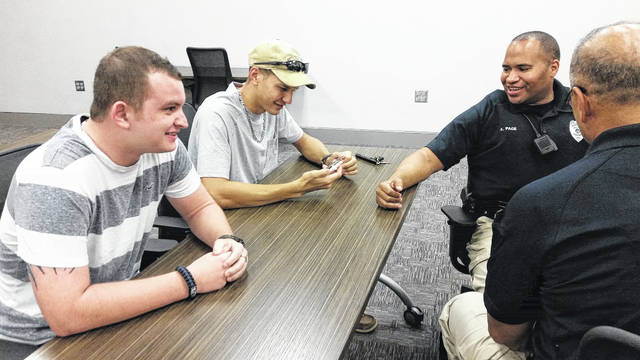LAURINBURG – Law enforcement officers in the county now have another tool in their arsenal to help save lives.
Eastpointe Managed Care recently donated 100 Narcan kits to Scotland County EMS. The kits were given to the Scotland County Sheriff’s Office and Laurinburg Police Department because EMS already carries Narcan, according to EMS Director Roylin Hammond.
The medication was offered to law enforcement because quite often they are the first ones on scene at a service callout.
The nasal spray kits would have cost $35 to $40 each if the departments had purchased them.
Narcan is a nasal spray which neutralizes the effects of an overdose from opiates. The medication, also known as naloxone, clears the opioids from the opiate receptors in the brain. It helps even if opiates have been are mixed alcohol or other drugs.
Opiates suppress breathing, and breathing can stop altogether in a person who has been given a heavy dose of opioids. Narcan blocks the effects and reverses the overdose.
True opioid overdoses are life-threatening emergencies, and the only way to reverse the effects is with Narcan, according to EMS Assistant Director Robert Sampson. In those cases time is of the essence.
“So with having these Narcan kits with our law enforcement partners, in a lot of cases they may get to these things quicker than we do,” Sampson said.
Narcan cannot be used to get high, and will not have any effect on a person who has not taken opiates.
Officers from both the sheriff’s office and the police department took classes this week to learn how to effectively use the medication for a suspected overdose.
There has been some controversy over first responders carrying Narcan. Detractors say the kits are a waste of tax dollars because addicts will not change an addict’s behavior. Some have even gone as far as to suggest that addicts should be allowed to die because they are not productive members of society.
Dan Picard, a council member in Middletown Ohio, echoed the thoughts of opponents of Narcan when he floated a proposal for “a three-strikes-style policy for people who repeatedly overdose: Too many overdoses and authorities wouldn’t send an ambulance to resuscitate them,” according to an article in the Washington Post.
Fortunately, EMS and law enforcement officers in Scotland County do not share his ideology.
“At the end of the day, we’re first responders. We don’t pick and choose who we save. They’re still citizens of this community,” said Police Chief Darwin “Duke” Williams.
It’s a sentiment shared by Chief Deputy Lloyd Goins of Scotland County Sheriff’s Office.
“It’s not up to us to judge an individual. We’ve been given a tool to try to help save a person’s life,” Goins said. “It’s not up to us to say who gets it and who doesn’t. It’s up to us to try to use the tools we have to try to preserve life.”
It’s rare for law enforcement to encounter a person who has overdosed. More often law enforcement’s interaction is with individuals under the influence of drugs but not to the point of overdose, according to Assistant Police Chief Terry Chavis.
Many times first responders are not called in until it is too late for intervention.
“In a lot of overdose cases, the way we find out is it’s a fatality. We probably go to more fatalities for overdoses than we go to situations where we actually administer Narcan,” Hammond said.
The kits are not just for victims of accidental overdose. More often first responders are being exposed to the fast acting, powerful and sometimes lethal drugs fentanyl and carfentanil at crime scenes and medical emergencies. Simple skin contact with a small amount of these drugs can be enough to kill. Having Narcan readily available could save the life of first responders as well.
“Fentanyl seems to be one of the most dangerous ones and carfentanil,” Sampson said. “What a lot of people don’t realize you have morphine which is an opioid medication, and you have fentanyl which is a hundred times more potent. And then you have carfentanil, which is the new synthetic drug, is a hundred times more potent than fentanyl. I hope that helps explain just how serious this can get and how dangerous it really is.”
These drugs are often mixed with heroin or passed off as drugs like oxycodone, Vicodin, or Methadone in order to make them more powerful and extend the drug dealer’s supply.
“That’s where we’re running into more problems. People are mixing things together, and it’s becoming deadly,” Hammond said.
Though Scotland County has not seen many overdoses or cases of fentanyl, first responders are aware that the problem is growing in surrounding counties and could soon spread.
According to Chavis, the Fayetteville Ppolice Department administered NARCAN more than 100 times in 2016.
Williams realizes how easy it is for epidemics to spread.
“We’ve all been educated on [fentanyl] and most of the time we know when it’s in surrounding states, and it has a tendency to migrate,” Williams said. “We can get from here to Charlotte in an hour and a half, Myrtle Beach in an hour and a half. They can use it in Myrtle Beach and come through here with the effects of it.”
“North Carolina has experienced 73% spike in opioid-related deaths since 2005,” according to statistics from Gov. Roy Cooper’s office.
According to the site, Robeson County went from five opioid related deaths in 2005 to 11 in 2015. Richmond County jumped as well with seven in 2005 and 11 in 2017.
Scotland County’s numbers fell from seven in 2005 to five in 2015.


